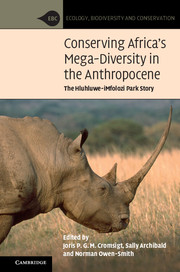Book contents
- Conserving Africa's Mega-Diversity in the AnthropoceneThe Hluhluwe-iMfolozi Park Story
- Ecology, Biodiversity and Conservation
- Conserving Africa's Mega-Diversity in the Anthropocene
- Copyright page
- Contents
- Contributors
- Foreword
- Preface
- Further Details on Zulu Place Names in the Hluhluwe-iMfolozi Park
- Acknowledgements
- Preamble
- Map
- Part I Setting the Scene
- Part II Theoretical Advances in Savanna Ecology
- 5 Megaherbivores, Competition and Coexistence within the Large Herbivore Guild
- 6 The Functional Ecology of Grazing Lawns: How Grazers, Termites, People, and Fire Shape HiP's Savanna Grassland Mosaic
- 7 Demographic Bottlenecks and Savanna Tree Abundance
- 8 Woody Plant Traits and Life-History Strategies across Disturbance Gradients and Biome Boundaries in the Hluhluwe-iMfolozi Park
- 9 Contributions of Smaller Fauna to Ecological Processes and Biodiversity
- 10 Interactions between Fire and Ecosystem Processes
- Part III Where Science and Conservation Management Meet
- Index
- Plate Section (PDF Only)
- References
6 - The Functional Ecology of Grazing Lawns: How Grazers, Termites, People, and Fire Shape HiP's Savanna Grassland Mosaic
from Part II - Theoretical Advances in Savanna Ecology
Published online by Cambridge University Press: 24 March 2017
- Conserving Africa's Mega-Diversity in the AnthropoceneThe Hluhluwe-iMfolozi Park Story
- Ecology, Biodiversity and Conservation
- Conserving Africa's Mega-Diversity in the Anthropocene
- Copyright page
- Contents
- Contributors
- Foreword
- Preface
- Further Details on Zulu Place Names in the Hluhluwe-iMfolozi Park
- Acknowledgements
- Preamble
- Map
- Part I Setting the Scene
- Part II Theoretical Advances in Savanna Ecology
- 5 Megaherbivores, Competition and Coexistence within the Large Herbivore Guild
- 6 The Functional Ecology of Grazing Lawns: How Grazers, Termites, People, and Fire Shape HiP's Savanna Grassland Mosaic
- 7 Demographic Bottlenecks and Savanna Tree Abundance
- 8 Woody Plant Traits and Life-History Strategies across Disturbance Gradients and Biome Boundaries in the Hluhluwe-iMfolozi Park
- 9 Contributions of Smaller Fauna to Ecological Processes and Biodiversity
- 10 Interactions between Fire and Ecosystem Processes
- Part III Where Science and Conservation Management Meet
- Index
- Plate Section (PDF Only)
- References
- Type
- Chapter
- Information
- Conserving Africa's Mega-Diversity in the AnthropoceneThe Hluhluwe-iMfolozi Park Story, pp. 135 - 160Publisher: Cambridge University PressPrint publication year: 2017
References
6.9 References
- 10
- Cited by



